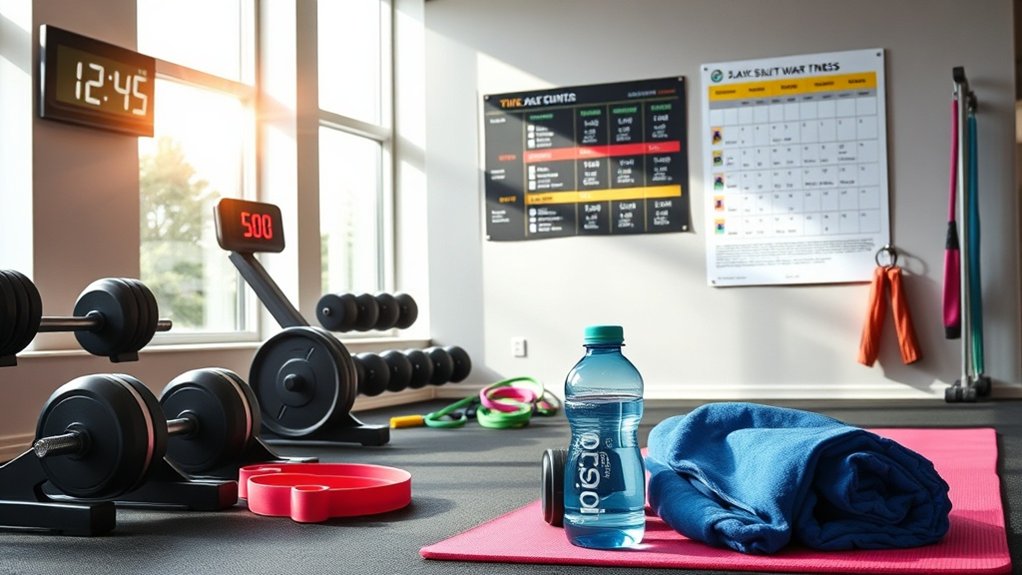You’ll train each major muscle group 2-3 times weekly on non-consecutive days (Monday, Wednesday, Friday), prioritizing compound movements like squats, deadlifts, and bench presses for maximum efficiency. Each session includes 4-6 exercises performed for 3-4 sets of 8-12 reps with 60-90 second rest periods, allowing ideal protein synthesis while maintaining adequate 48-hour recovery intervals between workouts. You can customize rep ranges and rest periods based on whether you’re targeting strength (3-5 reps), hypertrophy (8-12 reps), or fat loss (circuit-style training). The following sections provide complete templates and progression strategies tailored to your specific goals.
What Is a 3-Day Full Body Workout Split and How Does It Work?

A 3-day full body workout split structures your training into three weekly sessions, with each workout targeting all major muscle groups through a combination of compound and isolation exercises.
You’ll engage in strength training on non-consecutive days—typically Monday, Wednesday, and Friday—allowing ideal recovery between sessions.
This split emphasizes compound exercises like squats, deadlifts, and bench presses, which recruit multiple muscle groups simultaneously, maximizing efficiency and promoting hypertrophy.
The increased training frequency means you’ll stimulate each muscle group multiple times per week, which research links to superior strength gains.
If you’re a beginner, this approach is particularly effective because it prevents overtraining while building a solid foundation.
The training sessions balance volume and intensity, assuring consistent progress without overwhelming your recovery capacity.
The Science Behind Training Frequency for Full Body Programs
Why does training frequency matter so much for muscle development? Research demonstrates that higher training frequency—specifically 2-3 sessions per week per muscle group—significantly improves hypertrophy compared to once-weekly routines.
When you perform full body workouts three times weekly, you’re maximizing protein synthesis rates, which remain raised for approximately 48 hours post-training. This consistent stimulus accelerates muscle repair and drives superior strength gains.
Your 3-day split strategically balances training stimulus with adequate recovery time, preventing overuse injuries while supporting progressive overload. Studies confirm that individuals following this frequency demonstrate improved strength and endurance compared to lower-frequency programs.
The mechanism is straightforward: frequent muscle engagement triggers repeated protein synthesis responses, creating ideal conditions for muscle growth while allowing sufficient recovery between sessions for adaptation and performance improvement.
Building Your 3-Day Full Body Split: Exercise Selection and Volume Distribution

When constructing your 3-day full body workout split, exercise selection must prioritize multi-joint compound exercises that generate the highest mechanical tension across multiple muscle groups simultaneously. Your strength training foundation should include squats, deadlifts, bench presses, and rows for balanced development.
| Workout Day | Primary Compounds | Volume Distribution |
|---|---|---|
| Monday | Squat, Bench Press, Rows | 3-4 sets × 8-12 reps |
| Wednesday | Deadlift, Overhead Press | 3-4 sets × 8-12 reps |
| Friday | Lunges, Incline Press | 3-4 sets × 8-12 reps |
For beginners, supplement workout sessions with isolation movements for targeted muscle engagement. Schedule non-consecutive training days to optimize muscle recovery. This exercise selection strategy guarantees adequate intensity without excessive fatigue, promoting sustainable progression across all major movement patterns.
Complete 3-Day Full Body Workout Templates for Strength, Hypertrophy, and Fat Loss
Your training objectives determine the specific template modifications required for ideal adaptation—strength development demands neural efficiency through heavy loads at 3-5 reps with 3-5 minute rest intervals, hypertrophy necessitates metabolic stress and mechanical tension via 8-12 reps with 60-90 second rest periods, while fat loss programming integrates circuit-style training with shortened rest intervals of 30-45 seconds to maximize energy expenditure.
Each 3-Day Full Body Workout template prioritizes compound exercises like squats, deadlifts, and bench presses as primary movements. Your training frequency of three sessions weekly facilitates peak muscle growth through repeated stimulation without compromising recovery.
Workout templates should incorporate 4-6 exercises per session, balancing primary compound movements with targeted isolation work for balanced muscle development. This resistance training approach allows progression tracking across specific rep ranges while maintaining exercise variety to prevent adaptation plateaus and sustain continuous improvement toward your designated goal.
Progression Strategies and Recovery Management for 3-Day Training

Since progressive overload forms the foundation of all strength and hypertrophy adaptations, you’ll need systematic methods to advance training stress across your 3-day program while balancing recovery demands.
Increase training volume by adding 2.5-5% load weekly or one additional rep per set when you can complete all prescribed repetitions with proper form. Schedule 48 hours recovery time between sessions to optimize muscle growth and prevent accumulated fatigue.
Implement active recovery through low-intensity movement on off-days to improve circulation without compromising adaptation. Your nutrition directly impacts results—consume 1.6-2.2g protein per kilogram bodyweight daily alongside adequate calories.
Track your progress using a workout journal to document loads, repetitions, and subjective recovery markers. This data reveals when to adjust training volume or deload, making certain continued strength gains while managing fatigue appropriately.
Full Body Vs Split Routines: Advantages, Disadvantages, and Who Benefits Most
When designing your 3-day training split, you’ll need to choose between full body workouts that target all major muscle groups per session or split routines that isolate specific muscle groups each day.
Full body protocols allow higher training frequency (2-3x per week per muscle group) and greater time efficiency, while split routines enable increased volume and intensity for individual muscle groups with longer recovery periods.
Your ideal choice depends on your training experience, recovery capacity, and whether you’re prioritizing overall strength development or targeted hypertrophy in specific muscle groups.
Key Differences Explained
The fundamental distinction between full body and split routines lies in their approach to training frequency and volume distribution.
Full body workouts train multiple specific muscle groups each session, allowing you to hit everything 2-4 times weekly. This higher training frequency optimizes muscle hypertrophy and promotes balanced muscle development while remaining time-efficient. You’ll achieve overall strength gains with fewer gym visits.
Split routines concentrate training volume on isolated muscle groups per session, typically training each once weekly. This approach enables targeted muscle growth through increased exercise variety and intensity for specific areas.
Research demonstrates that the increased training frequency of full body workouts generally produces superior hypertrophy results. However, advanced lifters seeking aesthetic refinement may prefer split routines’ focused intensity, while beginners and time-constrained individuals benefit most from full body programming’s efficiency and balanced development.
Ideal Candidates Compared
Understanding these structural differences naturally raises the question of which approach fits your specific training profile.
If you’re a beginner seeking overall strength development, a Full Body Workout within your 3-Day Workout Plan maximizes training frequency while allowing adequate recovery time between sessions. This approach supports muscle hypertrophy through multiple weekly stimuli per muscle group, aligning with research showing 2-3x weekly frequency improves growth.
Conversely, advanced lifters pursuing specialized muscle hypertrophy often benefit from split routines, enabling higher volume targeting specific groups. Your individual fitness goals determine ideal selection: full body workouts provide thorough conditioning for general fitness, while splits accommodate bodybuilding-specific objectives.
Consider your experience level, recovery capacity, and training objectives when selecting your approach—beginners typically maximize results with full body programming.
Optimizing Your 3-Day Schedule: Exercise Order, Session Timing, and Implementation

Since recovery between training sessions directly impacts your strength gains and muscle adaptation, strategic scheduling of your 3-day workout plan becomes paramount to long-term progress.
Schedule full body training on non-consecutive days—Monday, Wednesday, Friday—guaranteeing ideal recovery between sessions.
Begin each workout with 5-10 minutes of warm-up, then prioritize compound exercises like squats and bench presses when you’re freshest.
Follow with isolation movements as fatigue accumulates. Your structured circuit should include 6-8 exercises targeting major muscle groups within 45-60 minutes.
Implement rest periods of 60-90 seconds for compound movements and 30-60 seconds for isolation work. This exercise order maximizes performance quality and session timing efficiency.
Apply progressive overload weekly by incrementally increasing weight or repetitions. This systematic implementation guarantees continuous muscular adaptation throughout your training split.
Frequently Asked Questions
What Is the 3-3-3 Rule in Gym?
The 3-3-3 rule’s a gym technique where you’ll perform three sets of three exercises per muscle group. This strength training approach optimizes workout duration, supports muscle recovery, and helps you achieve your fitness goals while preventing injury through focused exercise variety.
Should I Add a Full Body Day to My Workout Split?
You should add a full body day if you’re seeking increased training frequency and workout benefits. It’ll improve muscle recovery, support strength gains, and provide program variation. Consider your fitness goals, exercise selection preferences, and injury prevention needs when deciding.
What Is the 5 4 3 2 1 Training Method?
The 5 4 3 2 1 training method progressively decreases set volumes across five exercises, optimizing workout efficiency and muscle engagement. You’ll experience improved training intensity, strength progression, and performance tracking while maintaining adequate recovery time, supporting your fitness goals through systematic training adaptations.
What Is the 3 2 1 Rule in Gym?
Ironically, you’ll *gain* more by doing *less*: the 3-2-1 rule means three strength sets, two hypertrophy sets, one power set. This evidence-based approach optimizes strength training benefits while managing workout recovery strategies, confirming you’re maximizing muscle fiber recruitment efficiently.



